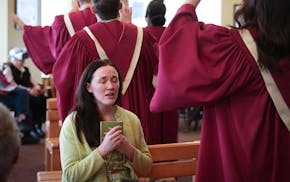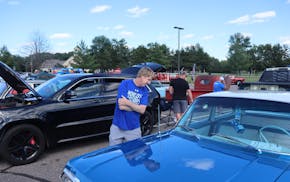While studying at the University of Minnesota, Doug Miller asked his American Indian history professor, "What happened to the American Indian Movement after Wounded Knee?" The prof suggested that Miller look into it.
Miller became so fascinated with learning about AIM and Native Americans that the then-aspiring alt-rock singer went on to become an associate professor specializing in Native history at Oklahoma State University and the author of two books about Indigenous people.
His latest is a biography of Jesse Ed Davis, the late Indigenous rock guitarist who played with Bob Dylan, the Rolling Stones, George Harrison, Eric Clapton, Jackson Browne, B.B. King and many others in the '70s and '80s.
"In some ways, this project never would have happened had my life not had a chapter in Minneapolis-St. Paul," Miller said in a recent phone interview from Stillwater, Okla.
Before he comes to St. Paul on Wednesday to discuss "Washita Love Child: The Rise of Indigenous Rock Star Jesse Ed Davis" at Landmark Center, Miller, 48, spoke to the Star Tribune. Here are excerpts.
Q: Your band Winter Blanket was from Moline, Ill. When and why did you relocate to Minneapolis?
A: We'd reached that stage where we needed to step up to a bigger market. We could go to Chicago or the Twin Cities. We were recording for Alan Sparhawk from Low's label, who was in Duluth. We had a nice following in the Twin Cities and we thought we'd be closer to the label. I was in Minneapolis from 2001 to 2007; then I left for Chicago to start graduate school.
Q: How did you get interested in Native American history?
A: I was a history major at the University of Minnesota because that's what I was good at in high school. My third year I took a Native American philosophy course as an elective. The experience turned my whole brain inside out and upside down. Then I started taking every Native American history and studies course I could. I just became enthralled with the subject. I'm not Native American myself. For the first time in my life, I was as enthusiastic about something as I had been about music. By 2007, I felt like we'd taken Winter Blanket as far as we could.
Q: That led to graduate school?
A: I graduated from the University of Minnesota in 2006. I got my master's degree from the University of Illinois in Chicago and then I got my Ph.D. at the University of Oklahoma in 2014. I took a job at Oklahoma State in 2015. I kind of went to the rival school.
Q: What is it like to be teaching Indigenous studies when you're not Indigenous?
A: I think about that a lot. I teach Native American history, it's an academic version. I don't teach Native culture. I can't do that and I couldn't do that if I wanted to. I think of myself as an ally who is helping people learn about Native American history, overturning assumptions and mythologies about it. Especially in Oklahoma, we have 39 tribal nations. There are 13 reservations in Minnesota. I also teach U.S. history and history through music, as well.
Q: What experiences did you have in Minnesota with Native culture?
A: It was a Native American history course I was taking with an Ojibwe professor named Jean O'Brien and she delivered her regular lecture on the American Indian Movement. ... AIM became my senior project. I got to know some founders and I started attending Twin Cities AIM board meetings and briefly was a board member. I used to help with their MySpace page back when that was a thing. I would help out at powwows. I went on to study urban Indigenous communities that became my research expertise based on those experiences in Minneapolis.
Q: How did you discover Jesse Ed Davis?
A: My oldest memory is my mother, father and I were driving from Tacoma [Wash.], where my father was stationed in the Army, back to Moline, Ill., where I was born. I was 3 or 4 years old and I remember three cassettes in the car I was obsessed with: Bob Seger's "Night Moves," Queen's "News of the World" and Jackson Browne's first album, with "Doctor My Eyes." So I've been listening to Jesse Ed Davis as far back as I can go. As far as I became hip to him, in the early 2010s, I just kind of noticed he was showing up in the liner notes in my record collection. It occurred to me I don't know anything about him. He played with three Beatles and he's a Native American from Oklahoma. I became intrigued by the mystery.
Q: Explain the book title's "Washita Love Child."
A: The Washita River runs through Oklahoma and sort of cuts through Norman, Okla., where Jesse was born. That title is also the title of his autobiographical song from his first solo album in 1970. He says "I was born on the bank of the Washita River/ in a Kiowa Comanche tipi." Now he's using some artistic license because he was born in the American naval hospital in Norman, not in a tipi. He means it metaphorically. I was trying to change the title to "Natural Anthem," which is another Jesse Ed Davis song. That ended up being the title of an exhibit I co-curated at the Bob Dylan Center that is running through July.
Q: Why is Jesse Ed Davis important?
A: He's all over many of the beloved albums from the late 1960s through the 1970s and through the '80s leading up to his untimely passing in 1988. He shaped the sounds of popular music. He's important too because of what he represents in American Indian history. We get to the '60s and '70s and everything bottlenecks into Red Power and the American Indian Movement and the Alcatraz occupation and Wounded Knee in 1973. Jesse Ed Davis represents other threads and themes that were emerging at that time for Native people. He represents an emerging American Indian professional class from that time that produced Indigenous lawyers and doctors and professional athletes and actors and so forth. He's important from two directions.
Q: The book is deeply researched and heavily footnoted. How did you go about balancing the academic vs. the storytelling?
A: For a subject who was quite literally homeless for a period in the 1980s, he didn't leave much of a paper trail. [Using] the liner notes as a road map to his story, I did just over 120 interviews. People like Jackson Browne, Taj Mahal, Robbie Robertson, Klaus Voormann helped me put the big story together. What I found is everybody knew a lot about one chapter of Jesse's life but nobody had the big story arc; even his bandmates and close friends and family members were surprised by the complete story I was able to put together. I was trying to suggest in those first couple chapters that there was a precedence in Jesse's Native ancestry to imagine doing great things and transcending the confining space that Native people are supposed to belong in.
Q: Please name five essential songs that Jesse Ed Davis played on.
A: You've got to have "Doctor My Eyes" by Jackson Browne. You've got to have Taj Mahal "Statesboro Blues" because that's going to inspire Duane Allman to play slide guitar. The Allmans told that story many times. A John Trudell song that Jesse did near the end of his life called "Beauty in a Fade" [represented] the work between those two Native brothers. The John Lennon version of "Stand by Me" with Jesse's slide guitar is so beautiful. And Bob Dylan "Watching the River Flow," and Leon Russell's on that, too.
Douglas K. Miller
What: Presentation on "Washita Love Child: The Rise of Indigenous Rock Star Jesse Ed Davis."
When: 7 p.m. Wed.
Where: Landmark Center, 75 W. 5th St., St. Paul.
Admission: Free, books will be for sale for $35.

Critics' picks: The 13 best things to do and see in the Twin Cities this week

Review: Beautiful singing and strong acting make Ten Thousand Things' 'Violet' a winner

54 festivals and fairs to check out this summer in Twin Cities suburbs

